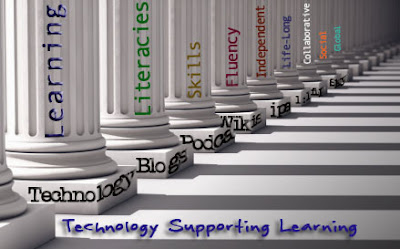Constructivist theory is a theory to explain on how knowledge is constructed in the human being when b information comes into contact with existing knowledge that has been developed by experiences. Constructivism as a theory of learning has existed for over one hundred years but has not been widely accepted or applied in public schools. This theory is just a posed of behavioral theory.
Technology-Supported Learning
- It is used to encourage students especially in facilitating student centered learning activities.
- It is more than technology enhance instruction. It recognizes that learning is supported in many different ways, even if there is no formal teaching involve.
- Students study and learn based on the way they are tested. The type of assessment anticipated appears to influence how and what they learn. Therefore, the quickest way to change the way students learn is to change the way learning is assessed.
In a technology-supported classroom, the student learns from and with the technology. Technology is seen as a source of information that the students learn from in the same way that the teacher are the source of information.. the students master facts from the concepts from technology and with the aid of technology.
For example, when a teacher is
engaging students in a learning opportunity, the instructor begins to question.
The process of questioning not only interests students in a topic, but also
gives the instructor an idea of the amount of prior knowledge a learner will
bring to the experience.
During the exploring stage,
"...students’ inquiry process drives instruction during an
exploration." Driving instruction is one purpose of assessment, whether in
a traditional or constructivist classroom.
During the explain stage,
communication occurs between student and teacher. At this point, an instructor
can input more information or points of inquiry as needed; again they are
actively assessing. Also during the explain stage, artifacts become available
that demonstrate concrete evidence of student understanding.
When students
begin to elaborate on their ideas and observations, possible avenues of future
research can develop.
Therefore,
evaluation as a stage is not meant to be solitary and final, but a constant in
each stage of constructivist learning (Miami Museum of Science, 2001).
Principle Tools and Methods Used in
Constructivist Assessment
Similarities and Differences Between Constructivist and
Traditional Assessment
a. Similarities
- Both types of assessment can take on a variety of formats: paper and pencil, physical hands on experience, or some type of exchange.
- The phrasing and use of critical thinking terminology in questioning can also be similar.
- Instructors in traditional classroom also use assessments in order to plan lessons and develop activities.
- Responses to traditional questions will also require more than a 'yes' or 'no' answer. However, the idea that interactive feedback occurs between evaluators and learners as well as the concept of judging the active construction of thinking as well as the outcome are greater priorities to the constructivist assessor than a traditional method of evaluation.
- Another difference lies in the support of standardized testing. Traditional learning environments support standardized testing and make many educational decisions off of those scores. The types of assessment preferred by constructivists would be: authentic, performance, or portfolio assessment. These types of assessment, according to Reeves & Okey, require more genuine thought from the learner and provide a more stimulating form of evaluation than traditional classroom testing


Walang komento:
Mag-post ng isang Komento